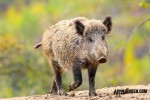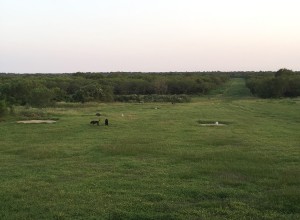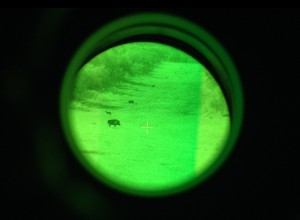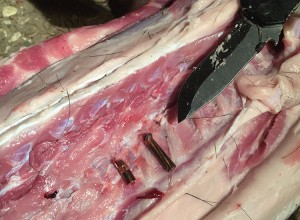Night Vision Pig Hunting Training with Wild River Ranch and Ironworks Tactical
Another hunt in the books for the crew at Ironworks Tactical, since it’s too early for deer we went after my other favorite game; Wild Pig!
This was a half business and half play trip with our affiliates at Wild River Ranch (WRR) in Texas. We have been affiliated with WRR for the past 2 years putting together hunting/training packages for hunters to learn newer hunting tactics used when hunting wild pigs. These tactics can also be applied for various predator hunts. Wild Pig hunting is one of the fastest growing sports in the hunting community. Unlike deer, elk or bear; pig hunting doesn’t have the normal daytime only hunting restrictions. In most states wild pigs are considered a nuisance due to the huge amount of destruction they can do in one night to a farmer’s crops. Their procreation rate is faster than anyone can keep up with, which is why eradication projects have never been able to get a foothold. They also have no natural predator, other than hunters. Wild pigs are not indigenous animals to the United States, and Fish and Game experts are finding that their populations are spreading, even to the coldest environments. However, there is a silver lining, they are a blast to hunt and they taste great!
Our trip started at 0’dark 30 on Friday morning, driving to the airport. I met up with 2 of the Ironworks Tactical Training Staff, and we hopped a flight into Houston where we picked up our rental car. One does not fly into Texas and pick up any old rental car! You have to get something that fits in, and screams manly hunter!!! So after we loaded up the Rav4 (it has got to be a Toyota!) and punched the address into the navigation, we grabbed some fast food and settled in for the drive to the ranch in South Texas. We were headed for the the San Antonio river bottom region, arriving at the Ranch after roughly 7 hours of travel.
We were blessed with great weather for Texas in August; it was a cool 90 degrees during the day with a low 70s at night which was when we would do most of our hunting. The first order of business for the IWT team was to check out the new training tools WRR had put in place for the IWT instructors to utilize for the hunters.
The program utilizes instructors from both IWT and WRR so that each of the cadre is teaching their specialty, which gives the hunter a wide range of tools to draw on. Off the front porch of the house is an 880 yard shooting range with steel targets at 50, 100, 150, 200, 300, 400, 500, 600, 700 and 800 yards. The targets out to 300 have vital zone swinging plates for more precise shooting. Off the main known distance range is the “scrambler”. The “scrambler” is used to teach the hunters how to work in a spotter and hunter team using thermal and night vision equipment in natural terrain. You read that right, thermal and night vision. We hunt pigs mostly at night as they are mostly nocturnal animals. I say mostly because they do move around in the day, but not nearly as often or as brazen as they do in the dead of night. The range isn’t completely cleared of tall grass; it’s designed to mimic what the hunter will see in a real world, hunting scenario. It forces the hunter to shoot off-hand, or from hasty supported positions, but doesn’t always allow the student to sit on the ground or prone out as these positions are just not feasible when out in the field hunting.
Once we checked out the great work WRR did on their “scrambler”, it was time to prep the gear before that evening’s first hunt, which would be done mainly on WRR itself. Normally the first night is nothing but training and running the scrambler, but since we were there to test gear as well, we opted to get an extra night of hunting in. The ranch is a 600+ acre piece of land set up for both deer and pig hunting. WRR has had ponds put in as part of a Ducks Unlimited project. Dr. Lucci is the owner, and head guide of WRR. He runs a tight ship, and believes in conservation, customer service and above all safety to his staff and the hunters.
Another order of business for the IWT staff was gear testing. As always we prefer to have the gear tested in real world scenarios as the last order of the testing phase. Jeff would be using one of WRR’s rifles that are offered to customers to use, if they don’t already have a night hunting setup. It is a 12.5” barreled AR15 rifle with a Wilson Whisper suppressor and TNVC D740 4x Gen 3 Night Vision Scope. In order to keep it lightweight for all-night stalking, and still have the stopping power and the range for pigs in full retreat, it was chambered in 6.8 SPC II. Jonathan was using a similar set up, his own rifle he had built. He provided a stripped AR15 lower that he already owned to have a complete rifle built by Ironworks Tactical. It is a 12.5” 6.8ARP (improved chamber over the SPC II) complete with Geissele trigger, Yankee Hill Suppressor and TNVC PVS-12 Aquila 4x Gen 3 Night Vision Scope. This is an extremely common pig hunting setup for us at IWT. I was using two different prototypes that we are currently working on at IWT. The first night I used one of our prototype 12.5” 6.8ARP Piston Upper halves, with Yankee Hill Suppressor and also a TNVC PVS-12 Aquila NV Scope. The second night, I would swap over to another Ironworks Tactical prototype upper half, which was a 8.5” 6.8 SPC II barrel capable of running both supersonic and subsonic rounds. It used the same suppressor and optic from the other prototype. While this upper was more suited to LEO and MIL work, it needed to be tested. So, what better way than on wild pigs? Dr. Lucci was running another version of the subsonic/supersonic upper half, but in a longer barrel, which would have excellent application in the predator hunting environment. He was also using the 200gr subsonic load while I was using the 90gr off the shelf XM90GD federal factory supersonic ammo.
Dinner time before the hunt was (as always) outstanding. WRR is known for their great hunts and their guarantee of getting you on game for a shot, but what not enough people talk about is their hospitality. Dinner consisted of venison and potatoes, and it was delicious. We all sat around the dinner table to eat and converse. This sit down time is a very important part of the weekend hunt activities, as it allows the hunters to get to know the guides and instructors. This way they feel comfortable around each other. That’s very important when you have people using equipment that they have never used before, more so when it is potentially very dangerous if mishandled. We don’t want anyone to be afraid to say “I need a little help with this or that, etc”. We also want the hunters to feel as much part of the WRR & IWT family as possible. I mentioned above that IWT and WRR have been affiliated officially now for 2 years but we’ve been hunting together far longer than that, so there is that bond all hunters get after several years of hunting together.
The first night on the prowl for pigs was on the WRR property only. We had a lot of land to work with, and lots of growth from the recent rains, so we had our night cut out for us. The wind was not in our favor, it was dead still. We would have preferred it in our face but it could have been worse. It could have been at our back making it nearly impossible to sneak up on anything. A short time into our first night, we snuck up on a large group of deer grazing and eating corn from a feeder. After watching these deer for a while, the realization that deer season was going to be great this year hit us! We saw some very large bucks with great 10 point racks in that group. Not just one, but several, the rainfall and heavy growth had been kind to the deer.
After a short time watching and waiting, we saw one lone but very large pig roll out to feed amongst the deer. It was odd that the deer didn’t run off when the pig came into the picture, but he was alone and paid them no mind, which led us to believe this was a normal occurrence. We were an easy 250 yards out from this pig and we had multiple deer between us and him. Due to the deer, there was no clear shot, and we contemplated stalking in closer but without the wind in our face the moment he smelled us he would be gone. On top of that, we had to sneak in closer without spooking the deer which would also alert him. So we waited and watched. Eventually a shot presented itself, over 220 yards offhand using a 4X optic. Not an easy shot. Anyone who hunts pigs frequently will tell you the primo shot placement on a pig is 2” behind the ear and 2” down into the neck, for a dead right there (DRT) shot. Too far back, and you’re in the armor plate that lies within the shoulder, which is a bad place to shoot them. The bullet just can’t penetrate that plate effectively. The heart/lung shot is a common shot amongst hunters on most animals. The problem with this shot on a pig is they will run before they die and pigs don’t leave blood trails to follow. So now the shot became more complicated and difficult, needless to say it resulted into a 20 yard run into heavy growth. Following a large, possibly wounded pig, into heavy growth is a recipe for disaster for the hunter. Jonathan would have his first pig ever that was not recovered, and the next morning the buzzards were circling very deep into the growth in just the right location.
We moved further down into the property towards what we call the haunted chair. Like many spots on the ranch, there is a story, but the stories are better told over dinner at the ranch. Like previously, we saw lots of deer with lots of great bucks. This time we also saw a good size sounder of pigs. Again, the deer were between us and them. The pigs headed into the bush as fast as they came into view and were gone from sight. After a few hours of this type of work, we headed back to the ranch for some much needed sleep, as we were quickly approaching being awake for 24 hours. Not a good combination with firearms and actively stalking at night. You start seeing things that are not there.
The next day, we had a late breakfast in the form of a frittata which consisted of eggs (of course), bacon, fresh jalapeno, tomatoes and a few other morsels making it pure goodness. We discussed the day time training that would be conducted for the second day, before putting it into practice. We are firm believers that we should constantly rehearse what we teach, so the hunters get their money’s worth and then some. After all that was done and it was mid-afternoon it was time to get some fun shooting in. We played a game of horse on the long distance range with various rifles. Jeff and Chris played Jonathan’s favorite game of “who can shoot the furthest steel plate with a pistol”, while I watched and called the shots. Jonathan normally amazes everyone by shooting the 400 yard steel target consistently with a pistol and sometimes even the 500 yard target.
Naps were taken and dinner was served. It was lasagna, salad and garlic bread before the big night of hunting. I say big night because it is a completely different experience than the first night of hunting. The first night was mainly for us because normally the student hunters would be working the scrambler all night in order to prepare for the second night; which would be the culmination of all the training into a pig hunt.
At about 10:30pm, the truck that takes the hunters out on their hunt showed up. A truck is used because there are several properties, and these different locations were going to be used for this night of hunting. The truck has a built out flat bed, with a steel tube railing around it for safety. It has two large suburban type seats back to back bolted down and looking outward. We took the truck to the first property, which was a farmed field with fresh cut corn and milo. The field looked like it was very flat, and you could see a long ways. However, even though it looked like it had been clear cut low to the ground, it was not. Everything was cut about knee high, which gave the pigs cover and made it harder to see them without a little patience, and the help of thermal optics. Once spotted with thermal, we would switch to night vision to ensure the animal is a pig, and not another animal like a bedded down deer. Only a few short minutes after arriving at the first property, the first stalk started. It was a 500 meter stalk, with a slight wind nearly at our back. One hunter and one spotter conducted the stalk to minimize any signature they were putting off. In order to get the wind out from their backs, they dog-legged to where they had seen the pig last. After a good 30-45 minutes, they were skunked and the pig had snuck away. They had done everything right, the pig just wasn’t cooperative.
We moved locations and scanned everything from afar, we decided to leave the truck behind and stalk towards another field. We were in luck! After a short walk we saw several pigs break from the tree line and head into the fresh cut milo. Milo crops looks similar to corn rows, and when cut, it’s about 25-30” tall and very difficult to sneak through quietly. It had been freshly cut a few days before. We made our way along the outside of the crop to have the light breeze in our face before heading in. We could not see anything inside the crop, except up and down each row or lane that we stepped into. After getting 75 yards into the crop, we saw a pig trotting across our lane, in the same direction we were traveling, about 100 yards to our left. We picked up speed, not as concerned about noise since the pigs were making their own noise. Finally, they had stopped, one was trotting towards us and several were stopped down the varying lanes we were in. I told Jeff to take the first shot once everyone was ready. After that shot, it was pure mayhem. Pigs were running in every direction, some across the lanes, some towards us and some away. It was exactly as expected, and we were able to take down several in that encounter. This type of hunting requires everyone to know where all the other hunters are, where there are clear fields of fire and be constantly aware of the four safety rules of firearms, especially clear target, back-stop and beyond.
After checking a couple of more locations, our driver had one honey hole up his sleeve. It was late into the night, or I should say, early morning at this point and we were all caught somewhat off guard when he switched on his headlights and drove into deep grass to scare up about 25 pigs which scattered in every direction possible. I jumped up, grabbed the railing of the truck, and ensured I had a clear downrange of anything other than pigs. I then dropped a pig at full run quartering away at about 135 yards, with the others doing the same. In the matter of about 5 minutes, we had 8 dead pigs on the ground, but we only recovered 6 to take back to the ranch and clean. The tall grass ate 2 of our pigs.
We loaded the 6 pigs and took them back to the ranch for inspection, cleaning and see if we could recover any of the subsonic bullets from the carcasses. We were fortunate to recover one subsonic 200gr 6.8 bullet. The pig had an entry wound in its neck just in front of its shoulder and through its chest to where the bullet was embedded, under the skin, just behind the opposite shoulder. The bullet mushroomed at the front and maintained its mass. The kill was inside 125 yards and everything on the subsonic 6.8 did as was designed. The funny thing is we also recovered another unknown bullet under a different pigs skin, we took a picture of both to show the size difference.
The prototype IWT complete uppers performed as expected. The piston upper ran flawless and was able to take 2 animals with the precise accuracy I come to expect from my Ironworks Tactical 6.8 complete upper builds. I hope to have them in the purchasing line-up very soon. The subsonic/supersonic uppers both also performed great. Each shooter/rifle took pigs with DRT shots running both supersonic 90gr bullets and subsonic 200gr bullets, proving the ability to run both types of ammo successfully. The next step with these will be piston systems. The piston is a huge benefit to the suppressed uppers as it keeps the gas blow back out of the hunters face. If not suppressed, I don’t see a reasonable point in the piston systems, as the DI system will work just as well. It also weighs less and has less moving parts to worry about losing or breaking.
After getting to bed at 5:30am Sunday, we woke up to eat, clean our kit and pack it up for our trip home. We relaxed some before we started our journey. Lastly, we packed the frozen meat in a cooler that would later travel home as checked baggage along with our rifles. Another great hunt weekend was in the books at Wild River Ranch! Our next trip to the Ranch would come soon enough, and we would be doing the same routine live with student hunters. These classes are already getting booked, and we are already scheduling our flights back so we can help improve a wild pig hunter’s effectiveness. It is by far one of our favorite things to do, and there is no greater joy than helping a hunter learn a new skill and be safe and effective in the process.
Night Vision Pig Hunting Training with Wild River Ranch and Ironworks Tactical – By: Brett Cifaldi of Ironworks Tactical
- Night Vision Pig Hunting Training with Wild River Ranch and Ironworks Tactical - September 22, 2015
- The Fall of the 6.8 SPC and Rise of the 6.8 SPC II as a Hunting Round - August 30, 2014






